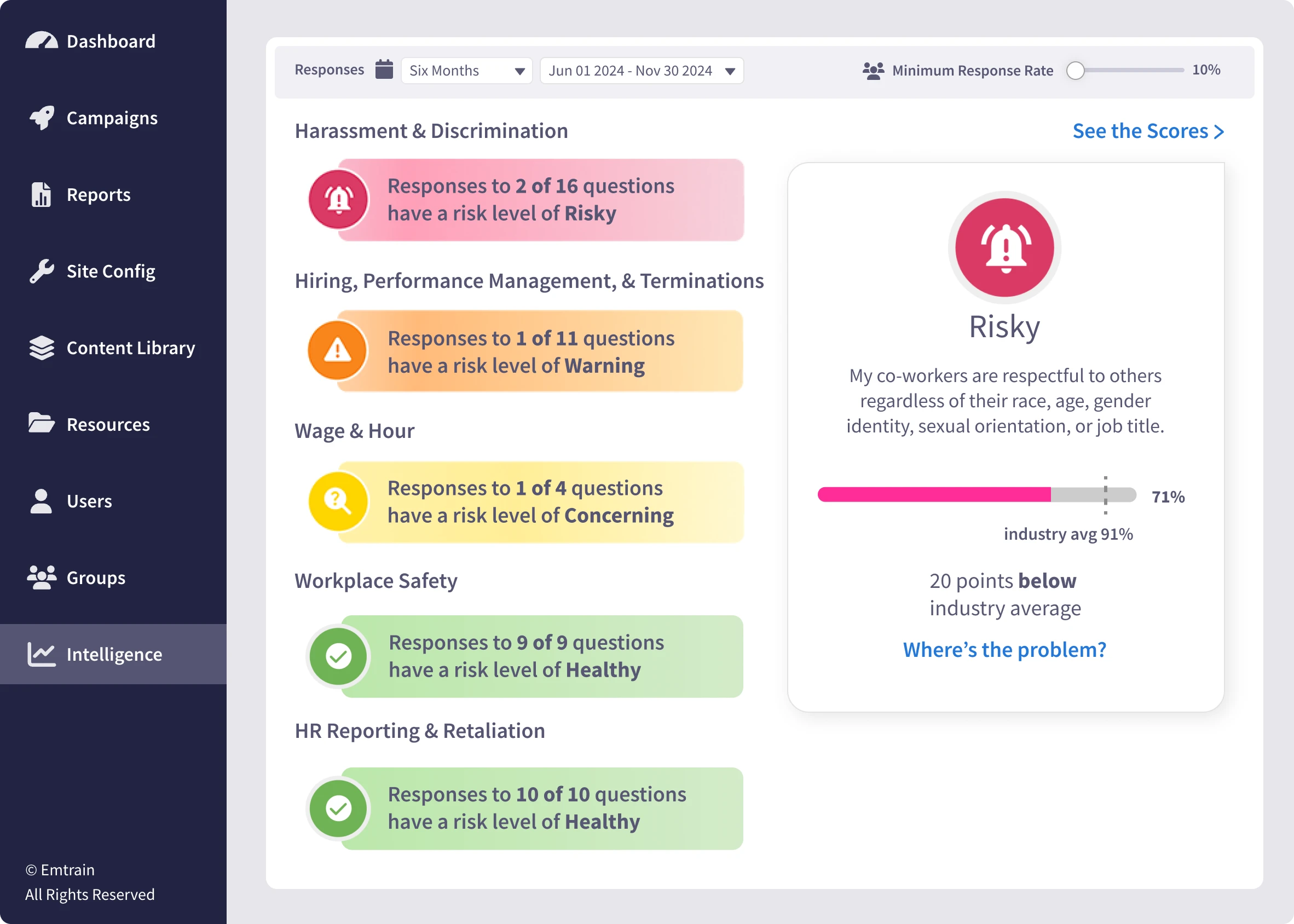Home » Concepts » Discrimination & Harassment » Bullying
Bullying is persistent, aggressive, or deliberate behavior that harms, humiliates, or undermines another individual at work. It goes beyond occasional conflict or criticism and typically exploits a real or perceived power imbalance. Bullying can be verbal, digital, psychological, or social and often results in decreased performance, isolation, and long-term emotional distress. In a workplace context, it threatens psychological safety and can escalate into legal or reputational risk.
Emtrain’s harassment training course is engaging, interactive, and designed to spot and reduce EEO risk.

Bullying has long been a recognized phenomenon in schools and social environments, but its presence in professional settings only gained widespread attention over the past two decades. As modern workplaces increasingly prioritize mental health, DEI, and employee well-being, bullying is now seen not merely as an interpersonal issue but an organizational and compliance concern. Research from organizations such as the U.S. National Institute for Occupational Safety and Health (NIOSH) underscores the connection between workplace aggression and long-term health outcomes.
Government agencies have begun highlighting the health and safety implications of workplace aggression, and large organizations have faced public criticism for failing to act. According to the U.S. Office of Personnel Management (OPM), promoting safe and respectful workplace environments is essential for protecting employee well-being and improving organizational performance. Bullying damages team cohesion, leads to avoidable turnover, and directly undermines a respectful culture—making it essential for leaders to understand and address.
The following examples reflect bullying patterns described in Emtrain’s cultural resources as well as additional scenarios recognized by national research institutions.
A manager consistently interrupts or talks over a team member in meetings. They roll their eyes, mock ideas, and exclude the employee from decision-making conversations. This pattern diminishes confidence and signals to others that disrespect is tolerated.
In a virtual environment, a coworker withholds key information, delays responses, or assigns blame publicly in team chats. Their behavior targets one individual repeatedly, leading to stress and performance issues.
An employee known for explosive anger outbursts doesn’t receive corrective feedback because “that’s just how they are.” Their volatility intimidates colleagues, who avoid collaboration or escalate issues instead of addressing them.
Team members purposely leave one person out of social gatherings, group messages, or collaborative discussions. The exclusion becomes systematic, affecting the employee’s professional opportunities and psychological safety.
A senior employee deliberately withholds tools, passwords, or process steps to ensure a colleague fails or appears unprepared. According to the Occupational Safety and Health Administration (OSHA), behaviors that interfere with another worker’s ability to perform safely and effectively can be indicators of workplace aggression.
Even when not tied to a legally protected characteristic, repeated jokes or ridicule about someone’s accent, appearance, caregiving responsibilities, or socioeconomic background can constitute bullying.
A supervisor selectively enforces performance standards—penalizing only certain individuals for minor issues while overlooking the same behavior in others. This persistent unequal treatment creates fear and undermines fairness.
The U.S. National Institute for Occupational Safety and Health (NIOSH) notes that hostile digital behavior—such as spreading harmful rumors, excluding others from channels, or using sarcasm and insults in written messages—can significantly impact mental health and psychological safety.
Bullying isn’t just a cultural issue—it’s a measurable business and compliance risk. Organizations that act early, empower leaders, and provide clear frameworks are better equipped to protect employee well-being and strengthen organizational culture. Bullying prevention is not a one-time initiative; it is an ongoing commitment that requires training, reinforcement, and strong leadership alignment.
An employee meets with her manager to discuss an upcoming report. The manager reacts with disbelief that the report isn’t finished and publicly insults the employee’s intellectual capabilities. Moments later, another team walks by and the manager assigns the project to someone else in front of her, reinforcing the humiliation. That team member later spreads a rumor questioning the employee’s abilities and warns others that she may be next on the “chopping block,” escalating the situation into a mob‑like targeting of her competence and reputation.
This scenario illustrates how quickly bullying can shift from a single harmful comment to a collective behavior that undermines psychological safety and damages team culture. It also shows how leaders’ actions influence peer behavior—positively or negatively. Bullying isn’t just a cultural issue—it’s a measurable business and compliance risk. Organizations that act early, empower leaders, and provide clear frameworks are better equipped to protect employee well-being and strengthen organizational culture. Bullying prevention is not a one-time initiative; it is an ongoing commitment that requires training, reinforcement, and strong leadership alignment.